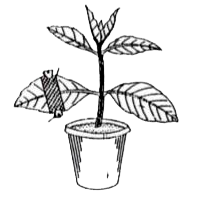What are the adaptations of leaf for photosynthesis ?
Step-by-Step Solution:
1. Introduction to Leaves and Photosynthesis:
- Leaves are the green parts of a plant and are primarily responsible for photosynthesis, which is the process by which plants prepare their own food using sunlight.
2. Presence of Chlorophyll:
- Leaves contain chlorophyll, a green pigment that plays a crucial role in trapping solar energy. This energy is essential for the photosynthesis process.
3. Flat Surface of Leaves:
- The flat surface of leaves allows for greater exposure to sunlight. This maximizes the area available for light absorption, which is vital for efficient photosynthesis.
4. Stomata for Gas Exchange:
- Leaves have numerous stomata, which are small pores located mainly on the lower surface of the leaf. These stomata facilitate the exchange of gases (like carbon dioxide and oxygen) and water vapor between the plant and the environment.
5. Role of Transpiration:
- The presence of stomata also aids in transpiration, which is the loss of water vapor from the plant. Transpiration helps in the ascent of sap, which is the movement of water and minerals from the roots to other parts of the plant.
6. Conclusion:
- The adaptations of leaves, including the presence of chlorophyll, the flat surface for sunlight exposure, and the stomata for gas exchange, are essential for the process of photosynthesis.
---
- Leaves are the green parts of a plant and are primarily responsible for photosynthesis, which is the process by which plants prepare their own food using sunlight.
- Leaves contain chlorophyll, a green pigment that plays a crucial role in trapping solar energy. This energy is essential for the photosynthesis process.
- The flat surface of leaves allows for greater exposure to sunlight. This maximizes the area available for light absorption, which is vital for efficient photosynthesis.
- Leaves have numerous stomata, which are small pores located mainly on the lower surface of the leaf. These stomata facilitate the exchange of gases (like carbon dioxide and oxygen) and water vapor between the plant and the environment.
- The presence of stomata also aids in transpiration, which is the loss of water vapor from the plant. Transpiration helps in the ascent of sap, which is the movement of water and minerals from the roots to other parts of the plant.
- The adaptations of leaves, including the presence of chlorophyll, the flat surface for sunlight exposure, and the stomata for gas exchange, are essential for the process of photosynthesis.
Topper's Solved these Questions
- BOOK - NCERT EXEMPLAR ENGLISHCHAPTER - LIFE PROCESSESEXERCISE - Long Answer Type Questions11videos
LIFE PROCESSES
- BOOK - NCERT EXEMPLAR ENGLISHCHAPTER - LIFE PROCESSESEXERCISE - Long Answer Type Questions11videos
LIFE PROCESSES
- BOOK - NCERT EXEMPLAR ENGLISHCHAPTER - HOW DO ORGANISMS REPRODUCEEXERCISE - Long Answer Type Questions10videos
HOW DO ORGANISMS REPRODUCE
- BOOK - NCERT EXEMPLAR ENGLISHCHAPTER - OUR ENVIRONMENTEXERCISE - LONG ANSWER TYPE QUESTIONS8videos
OUR ENVIRONMENT
Similar Questions
Knowledge Check
- Question 1 - Select One
Adaptation may be
AbehaviouralBmorphologicalCphysiologicalDall of these
The diagram below represents an experiment conducted to prove the importance of a factor in photosynthesis
Study the same and then answer the questions that follow

Why was the experimental leaf kept in (1) boiling water (2) methylated spint?View SolutionWhat are the raw material for photosynthesis?
View SolutionVolant adaptation is for
View SolutionVolant adaptation is for
View SolutionIn which plant stipules become leaf like for photosynthesis ?
View SolutionPhotosynthetic organisms occur at different depths in the ocean. Do they receive qualitatively and quantitatively the same light ? How do they adapt to carry out photosynthesis under these conditions.
View SolutionIs it correct to say that photosynthesis occurs only in leave of a plant ? Besides leaves, what are the other parts that may be capable of carrying out photosynthesis ? Justify.
View Solution

